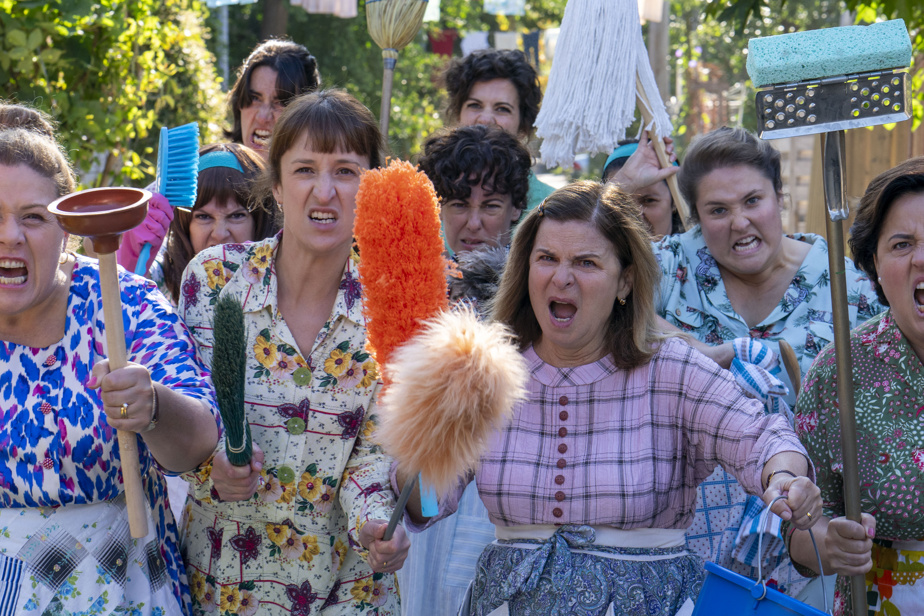A modest housewife from Plateau Mont-Royal, Germaine Lauzon (Geneviève Schmidt) has just won a million stamps. She rushes to invite her sister Rose Ouimet (Anne-Élisabeth Bossé), her sister-in-law Thérèse Dubuc (Guylaine Tremblay), always flanked by her poor mother-in-law Olivine Dubuc (Véronique Le Flaguais), and her friends to a party of gluing stamps.
In addition to Linda Lauzon (Jeanne Bellefeuille), who is forced to attend the party by her mother Germaine, Yvette Longpré (Ariane Moffatt), Lisette de Courval (Valérie Blais), Des-Neiges Verrette (Debbie Lynch-White), as well as the inseparable Angéline Sauvé (Diane Lavallée) and Rhéauna Bibeau (Pierrette Robitaille) will be there. Against all odds, Pierrette Guérin (Véronic Dicaire), who her sisters Germaine and Rose have not seen for years, will show up at the party.
By tackling the big screen adaptation of the musical version of Sisters in lawcreated in 2010 with Daniel Bélanger, based on the play by Michel Tremblay staged in 1968 by André Brassard, René Richard Cyr wanted to start from scratch. Having sacrificed scenes and characters for the 2010 version, the director did not hesitate to remove scenes and ask the composer to shorten songs for this reinterpretation.
If the film starts off with a bang with theOde to Bingowhere Benoît Brière, surrounded by Germaine and her band, dances with ease to a lively choreography by the duo Team White, Our sisters-in-law sees its cruising speed weighed down very early on by editing that lacks tone. Thus, the sequence where Germaine phones her neighbors seems to last an eternity.

PHOTO PROVIDED BY TVA FILMS
Image from the film Our sisters-in-law
Certainly, René Richard Cyr had the good idea of letting us enter the home of each of the sisters-in-law in order to capture them in their daily lives. Not only does he avoid falling into the trap of filmed theater, but he also takes the opportunity to give a face to the husbands of Germaine (Steve Laplante), Rose (Guillaume Cyr) and Yvette (Olivier Aubin). We even discover Johnny (Maxime Le Flaguais), the one who breaks Pierrette’s heart.
In some issues, notably The clubsthe editing is so messed up that the actress who sings does not appear on screen. At times, it is the continuity of the choreography that suffers. The problem of rhythm is also encountered during the final sequence, where, once again, the director follows his characters in their intimacy. By emphasizing what Germaine’s guests are experiencing, the director lessens the shock that the latter endures. In the absence of a moving final scene, he nevertheless signs numbers where emotion is present.
Debbie Lynch-White performs magnificently My brush sellerwhere she performs a delightful pas de deux with René Richard Cyr, touching as an old bachelor in love – a choice imposed by producer Denise Robert. On edge, Anne-Élisabeth Bossé delivers a moving interpretation of Damn asswhile Véronic Dicaire proves to be heartbreaking on Johnny’s fucking day.
René Richard Cyr directs his choir of actresses with a master’s hand. Ariane Moffatt is driven by an inexhaustible joie de vivre; Valérie Blais hits the mark with every line; Diane Lavallée skillfully combines humor and vulnerability; and Jeanne Bellefeuille, a newcomer of barely 19, displays great intensity. Assisted by Yves Bélanger as director of photography, the director favors close-ups so much that he seems to probe the souls of his characters.
Alongside a Guylaine Tremblay filled with desire, Véronique Le Flaguais conveys the contained rage of her Olivine, a victim of abuse. Rarely has Pierrette Robitaille’s gaze appeared so serious on the big screen. As for Geneviève Schmidt’s, radiant, it translates in turn quiet happiness and silent despair.
Breaking with the miserable aesthetic that we immediately associate with Sisters-in-lawseen at the cinema in Once Upon a Time in the East (1974), by André Brassard, Cyr proposes in Our sisters-in-law a pop aesthetic where acidulous colors joyfully dominate. Resolutely flirtatious despite some periods of scarcity, her sisters-in-law appear in all their splendor, their pride and their femininity. After all, there is nothing too beautiful for the working class!
In addition to warm vintage decor, including a restaurant evoking Françoise Durocher, waitress (1972), by André Brassard, René Richard Cyr serves us on a silver platter a nod to Tremblay’s work. In this amusing scene, the playwright and Denise Filiatrault, who was Rose Ouimet and Pierrette Guérin on stage, play a couple as adorable as they are improbable.
In theaters July 11

Drama
Our sisters-in-law
Rene Richard Cyr
Genevieve Schmidt, Anne-Elisabeth Bossé, Guylaine Tremblay
1 h 42
